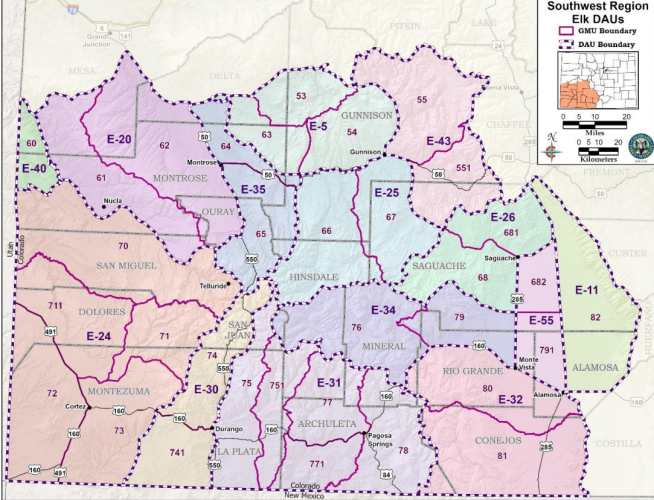
DURANGO, Colo. – Colorado Parks and Wildlife seeks input on draft Herd Management Plans (HMPs) for 14 elk herds occurring in southwest Colorado. The draft plans are now open to public review and comment through Dec. 20.
These herds include the E-05 West Elk Mountains, E-11 Sand Dunes, E-20 Uncompahgre Plateau, E-24 Disappointment Creek, E-25 Lake Fork, E-26 Saguache, E-30 Hermosa, E-31 San Juan Basin, E-32 Lower Rio Grande, E-34 Upper Rio Grande, E-35 Cimarron, E-40 Paradox, E-43 East Gunnison Basin and E-55 Northern San Luis Valley Floor elk herds.
CPW is proposing extensions of previously-approved management objectives for all but three of these herds. Extensions are recommended when CPW staff believe a continuation of the previous objectives, course of management actions and strategies are sufficient for a given herd. CPW is not proposing any changes to objectives or management approach for 11 HMPs, all of which were approved by the Parks and Wildlife Commission within the last few years.
CPW is proposing new management objectives for the Uncompahgre Plateau, Paradox and East Gunnison Basin herds, which have current management objectives more than 10 years old.
“The proposed herd management plans will guide management of the 14 elk herds in the Southwest Region for a 10-year period through 2033,” said CPW Senior Wildlife Biologist Jamin Grigg, “These 14 elk herds contain an estimated 122,000 elk, representing nearly 44% of the statewide total population estimate of 280,000 elk.”
The primary purpose of HMPs is to establish management objectives for each herd in terms of a desired population size range and sex ratio. The management alternatives selected in these plans will drive annual elk license setting decisions. License setting and the resultant annual harvest modulate elk population numbers to meet population and sex ratio objectives.
Each plan also describes additional strategies and techniques that will be used to achieve the desired herd objectives. The goal for the 10-year term of these plans is to manage to the most appropriate population level within the objective range based on climatic patterns, habitat conditions, forage availability and public desires.
Here is a closer look at the three Data Analysis Units where revisions to HMPs are proposed:
Uncompahgre Plateau
The last HMP for E-20, which includes Game Management Units 61 and 62 within parts of Delta, Mesa, Montrose, Ouray and San Miguel Counties, was approved in 2006.
The plan called for a population objective of 8,500 to 9,500 elk. The 2021 population estimate for this herd was 12,500.
CPW’s preferred alternative for this herd is to increase the population objective to 11,000 to 15,000 elk and to increase the bull to cow ratio from 16-20 bulls per 100 cows to 20-25 bulls per 100 cows.
“With limited carrying capacity because of drought, poor winter range conditions, increasing recreation and the potential for increased game damage if a hard winter occurs, CPW plans to stabilize this herd near current population levels,” said CPW wildlife biologist Alyssa Kircher. “The proposed objective range of 11,000 to 15,000 allows for management flexibility if the drought lessens, allowing range conditions to improve and to support more elk on the landscape.
“Increasing this herd more than within the proposed objective range would likely negatively impact the already compromised range condition and increase game damage complaints. Decreasing this herd was not desired by CPW staff or stakeholders. Stabilizing this herd balances the need for maintaining quality habitat during drought conditions yet still allowing for similar hunting opportunities as in recent years.”
Paradox
The last HMP for E-40, which includes Game Management Unit 60 within parts of Montrose and Mesa Counties along the Utah state line, was approved in 2008.
The previous population objective was 900 to 1,100 elk. The 2021 population estimate was 1,400.
CPW’s preferred alternative is to increase the population objective to 1,200 to 1,600 elk and to keep the status quo sex ratio of 25-30 bulls per 100 cows.
“With limited carrying capacity because of drought, poor conditions on winter range and pending CWD spread, increasing this herd is not logical,” Kircher said. “Game damage would likely escalate in Paradox Valley with an increasing elk herd, and CPW would like to limit big game impacts on private land. Decreasing this herd would be difficult because of constant variation in herd size and the lack of demand for limited licenses. Stabilizing the herd to the best extent possible will keep game damage complaints low, CWD prevalence in check and maximize hunting opportunities.”
East Gunnison Basin
The last HMP for E-43, which includes Game Management Units 55 and 551 within parts of Gunnison and Saguache Counties, was approved in 2001.
The previous population objective was 3,000 to 3,500 elk, while the 2021 population estimate was 6,700.
CPW’s preferred alternative is to increase the population objective to 6,200 to 7,200 elk and to maintain the status quo sex ratio of 23 to 28 bulls per 100 cows.
“The previous objectives for this herd were set using an older modeling method that likely underestimated the population size of this herd,” Grigg said. “We are proposing changing this population objective based on the new model that more accurately enables us to manage this herd within the objective ranges desired by the stakeholders.”
The draft elk plans are open to public comment through Dec. 20. Please submit public comments to Grigg at [email protected].
Comments also will be accepted by mail addressed to:
Colorado Parks and Wildlife
Attn. Jamin Grigg
415 Turner Drive
Durango, CO 81303




